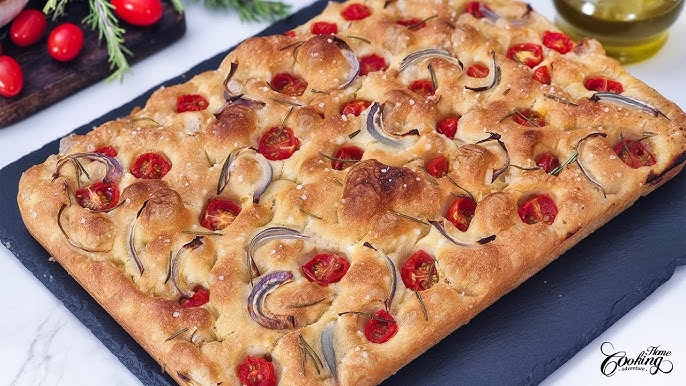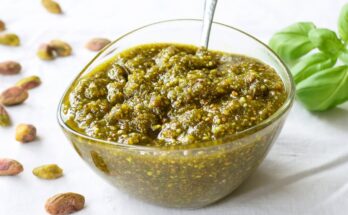Easy Focaccia Recipe: Imagine biting into a golden, crispy, yet tender slice of focaccia—fluffy on the inside and infused with olive oil and herbs on the outside. Whether you’re a seasoned baker or just getting started, this easy focaccia recipe is your gateway to mastering one of Italy’s most beloved breads. The best part? You don’t need fancy tools or rare ingredients. Just a bit of time, love, and olive oil.
What is Focaccia Bread?
Focaccia is a flat oven-baked Italian bread known for its rich olive oil flavor, pillowy texture, and signature dimples. It hails from Liguria, a coastal region in northwest Italy. Traditionally, it’s topped with simple ingredients like rosemary and sea salt, but it can also be loaded with toppings ranging from olives to tomatoes to onions.
It’s incredibly versatile—served as a side, used in sandwiches, or simply enjoyed with a drizzle of balsamic vinegar. Its chewy yet airy texture makes it stand out from other breads, and the crisp bottom crust is just chef’s kiss.
Ingredients You’ll Need
The beauty of focaccia lies in its simplicity. Here’s everything you need to make a classic version:
- All-purpose flour – The base of your dough; make sure it’s fresh.
- Active dry yeast – Helps the dough rise and gives that airy structure.
- Warm water – Activates the yeast and hydrates the dough.
- Olive oil – Essential! It adds flavor and moisture.
- Salt – Enhances taste and balances sweetness.
- Sugar – Feeds the yeast for better rise.
- Fresh rosemary (optional but recommended) – Classic focaccia topping.
- Flaky sea salt – For that crunchy finish on top.
Optional toppings include cherry tomatoes, garlic, caramelized onions, or even cheeses.
Why This Recipe Works
This focaccia recipe is all about ease and flavor. It’s perfect for beginners and pros alike because:
- No kneading required: A simple mix and rest process does all the work.
- Flexible timing: You can make it same-day or let it cold-ferment overnight for deeper flavor.
- Crispy bottom, fluffy interior: Achieved by using generous olive oil and high-temperature baking.
- Endlessly customizable: You can switch up herbs, add toppings, or even make it sweet.
You’ll end up with a golden, rustic bread that smells like an Italian bakery and tastes even better.
Step-by-Step Guide to Making Focaccia
Step 1: Mixing the Dough
Start by combining warm water (about 110°F), sugar, and yeast in a large mixing bowl. Let it sit for about 5–10 minutes until it gets frothy—this means the yeast is alive and kicking.
Next, stir in the flour and salt. Use a wooden spoon or your hands to mix everything together until no dry patches remain. The dough will be sticky, and that’s totally normal! Drizzle olive oil over the top to keep it from drying out and cover the bowl with plastic wrap.
Step 2: First Rise
Let the dough rest in a warm place for 1 to 2 hours, or until it has doubled in size. You can also put it in the fridge for a slow overnight rise, which adds amazing flavor. The dough should be bubbly and very soft.
Step 3: Shaping and Second Rise
Coat a 9×13 baking dish or sheet pan generously with olive oil. Gently pour the dough into the pan. With oiled fingers, stretch and press it to fit the pan—don’t worry if it springs back a bit.
Cover it again and let it rest for another 30 to 45 minutes. It will puff up nicely and be ready for the final step before baking.
Step 4: Dimpling and Topping
Now the fun part: dimpling! Use your fingers to press deep indentations all over the dough. This gives focaccia its iconic look and helps hold the toppings.
Drizzle more olive oil over the top, sprinkle with flaky sea salt, and add your toppings—rosemary is a classic choice, but you can get creative here.
Step 5: Baking to Perfection
Preheat your oven to 425°F (220°C). Bake the focaccia for 20–25 minutes, or until the top is golden brown and the edges are crispy. It should smell absolutely amazing.
Remove from the oven and let it cool slightly before slicing. Serve warm, or store for later.
Tips for the Best Homemade Focaccia
If you want bakery-quality focaccia right from your own kitchen, these pro tips can make all the difference:
- Use high-quality olive oil: This is the soul of focaccia. A fruity, peppery extra virgin olive oil will elevate the flavor dramatically.
- Let it rest: Don’t rush the resting times. The longer the dough rises (especially during cold fermentation), the more flavor you’ll get.
- Keep it wet: Focaccia dough should be very hydrated. Don’t be tempted to add more flour if it’s sticky—embrace the stickiness.
- Generously oil the pan: This not only prevents sticking but also gives the bread that signature crispy bottom.
- Get creative with toppings: From roasted garlic and olives to sun-dried tomatoes and onions, the sky’s the limit.
- Don’t skimp on salt: The final sprinkle of flaky salt brings out all the flavors and adds an irresistible crunch.
Think of focaccia as a blank canvas—simple techniques paired with quality ingredients go a long way.
Delicious Focaccia Variations
While the classic rosemary version is a staple, focaccia is incredibly versatile. Here are some tasty ways to change things up:
- Garlic and Herb Focaccia
- Add minced garlic and mixed Italian herbs for a savory twist.
- Tomato and Basil Focaccia
- Press halved cherry tomatoes and fresh basil leaves into the dough before baking. Drizzle with balsamic glaze for a Caprese-inspired bite.
- Olive and Onion Focaccia
- Scatter sliced red onions and Kalamata olives across the surface. This combo is full of Mediterranean flair.
- Cheese Lover’s Focaccia
- Sprinkle shredded mozzarella or parmesan on top for a cheesy, crispy layer.
- Sweet Focaccia
- Try apples, cinnamon, and a sprinkle of sugar for a dessert-style version. A light drizzle of honey after baking seals the deal.
Whatever toppings you choose, make sure they’re thinly sliced and evenly distributed so they cook evenly and don’t weigh down the dough.
Serving Suggestions
Wondering how to enjoy your fresh-baked focaccia? Here are a few delicious ideas:
- Appetizer: Serve it with a dip made from olive oil, balsamic vinegar, and crushed garlic.
- Side Dish: Pair with soups like tomato basil or minestrone for a hearty meal.
- Sandwich Bread: Slice horizontally and load it with your favorite fillings—think grilled veggies, mozzarella, and pesto.
- Snack: Just a piece on its own with a cup of coffee or tea makes a cozy afternoon bite.
- Charcuterie Boards: Cut into squares and serve with cheeses, olives, and cured meats.
Focaccia is like the Italian cousin of your favorite comfort bread. It fits into almost any meal like it was meant to be there.
Storing and Reheating
Homemade focaccia is best fresh, but you can still enjoy leftovers if you store it right:
- At room temperature: Wrap tightly in foil or place in an airtight container. It will keep for up to 2 days.
- In the fridge: Store for up to 5 days, but be aware it may dry out a little faster.
- Freezer-friendly: Freeze focaccia for up to 2 months. Wrap slices individually in plastic wrap and place in a freezer-safe bag.
To reheat: Warm slices in a 350°F oven for 8–10 minutes or until heated through. This brings back the crispiness beautifully.
Avoid microwaving if you can—it softens the crust too much and kills that satisfying crunch.
FAQs about Easy Focaccia Recipe
1. What is focaccia bread?
Focaccia is a classic Italian flatbread that’s soft, airy, and rich in olive oil flavor. It’s often topped with herbs, garlic, or vegetables and can be enjoyed on its own or as a sandwich base.
2. Do I need special flour for focaccia?
No, all-purpose flour works great for homemade focaccia. However, using bread flour can give it a slightly chewier texture.
3. How long does focaccia dough need to rise?
Typically, focaccia dough needs at least 1 to 2 hours to rise. For a deeper flavor, you can refrigerate it overnight for a slow fermentation.
4. Can I freeze focaccia bread?
Yes! After baking, let it cool completely, wrap tightly in plastic wrap and foil, then freeze. It stays fresh for up to 3 months. Reheat in the oven for the best texture.
5. How do I get that crispy crust?
The secret is olive oil! Generously coat the baking pan and drizzle some on top before baking. A hot oven also helps crisp up the edges beautifully.
6. What toppings can I use on focaccia?
Popular options include rosemary, sea salt, cherry tomatoes, garlic, olives, and caramelized onions. Feel free to get creative!
7. Can I make focaccia without yeast?
Traditional focaccia requires yeast for its signature rise and airy texture. But you can try baking powder-based versions for a quicker alternative, though the texture will differ.
8. Is focaccia gluten-free?
Standard focaccia is not gluten-free. However, you can use gluten-free flour blends designed for yeast breads to create a similar version.
9. Why is my focaccia dense and not fluffy?
This could be due to under-proofing or overmixing the dough. Ensure the dough rises fully and handle it gently after the first rise.
10. How should I store leftover focaccia?
Wrap it in foil or place in an airtight container at room temperature for up to 2 days. For longer storage, refrigerate or freeze it. Reheat before serving for best results.
Conclusion
And there you have it—a foolproof, easy focaccia recipe that brings the rustic warmth of Italy into your own kitchen. With just a handful of ingredients and a bit of patience, you can bake a loaf that’s golden, fluffy, and full of rich flavor. Whether you keep it classic or dress it up with your favorite toppings, focaccia is a bread you’ll come back to again and again.
It’s more than just bread—it’s a blank canvas for creativity, a crowd-pleaser at the dinner table, and the perfect bite alongside your favorite dishes. So roll up your sleeves, pour that olive oil, and get baking. You’re just one loaf away from a new favorite recipe.



